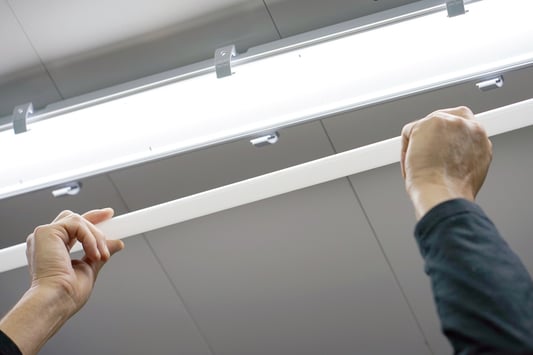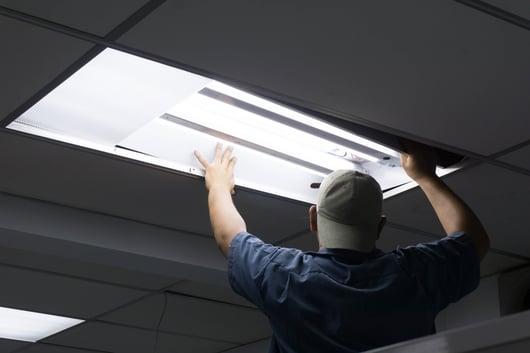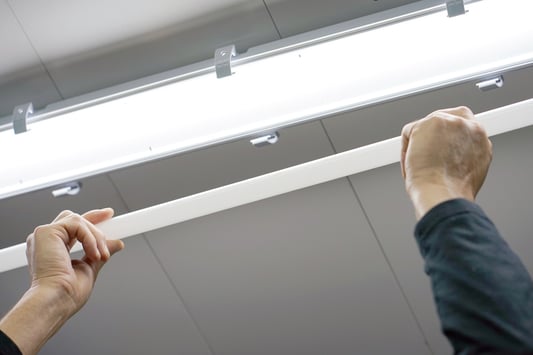LED lighting upgrades can be classified into three broad types based on how much the existing installation is modified: lamp replacements, retrofits and fixture replacements. It is usually possible to achieve higher performance by upgrading more components of the lighting system, but the cost of the project also increases. However, governments and utility companies can introduce rebate programs for energy-efficient lighting, and an expensive project can end up being cost-effective after a good rebate.
As with any energy efficiency measure, a technical and financial analysis of the project is highly recommended before proceeding. This way, you can prioritize the specific updates that yield the highest return on investment . Although many factors determine project performance, the following tend to be the most relevant:
- Upgrading lighting systems with long operating hours first is recommended. Keep in mind that energy savings are the product of energy saved and hours of use. The most efficient LED bulb on the market won't save much energy if the equipment you install it in is rarely used.
- Interior lighting upgrades in air-conditioned and refrigerated spaces provide two types of savings: a direct reduction in lighting power, and also a reduction in the amount of heat handled by the cooling equipment.
- The project achieves better results when the technological gap between the proposed and existing lighting system is wider. For example, upgrading from incandescent lighting to LED generates more savings than upgrading from fluorescent lighting, even though the final project consumes the same energy in both cases.
This article will provide a brief overview of the main types of lighting upgrades, along with general recommendations for each case.
Lamp Replacements
The simplest type of lighting upgrade is to replace existing bulbs with better-performing equivalent versions. This type of lighting upgrade can be accomplished quickly and at a relatively low cost, making it an attractive option for businesses that want to minimize outages or that have a limited budget for energy efficiency projects. The main aspects to consider before replacing a lamp are the following:
| FIXTURE/LAMP PROPERTY | IMPORTANCE |
| Lamp base compatibility |
Proposed replacement lamps must be compatible with existing luminaire sockets. Most bases use an Edison screw or multiple pins, and LED upgrades are available in each case.
|
| Ballast compatibility | Many replacement bulbs are designed for the same ballasts used by previous bulbs, making upgrading extremely simple. However, replacement bulbs may also be designed to connect directly to the power supply, and if this is the case, you will have to rewire the fixture and bypass the ballast. Some upgrade bulbs are universal, compatible with both ballast and direct plug. |
| Light beam shape | Do not assume that two lamps with the same base shape can be used in place of each other, as the beam shape varies drastically depending on the application. For example, you can find globe bulbs and parabolic bulbs with medium bases (E26), but the globe bulb projects light in all directions while the parabolic bulb focuses it into a narrow beam. |
Replacement lamps must also be selected with suitable lighting properties depending on each application. They must provide sufficient illuminance (lumens per square meter) while having the correct color temperature (CCT) and the highest possible color rendering index (CRI) that meets the project budget.
- Low CCT values (warm colors) work best when you want to create a relaxing environment, while high CCT values (cool colors) are recommended when visibility and awareness are important – in sports venues and manufacturing applications, for example.
- On the other hand, CRI is not specific to each application; higher color reproduction is always better, but it usually costs more.
Lighting designers use software like DIALux to simulate specified fixtures and fixtures, ensuring they provide adequate lighting for the intended application.

If you are looking for replacement bulbs, be sure to purchase products with the blue ENERGY STAR logo, which guarantees high performance and intensive laboratory testing. In commercial and industrial applications you can find the DLC (Design Lights Consortium) label. Both programs have very strict labeling requirements, so their respective logos indicate high quality and performance. They are mutually exclusive for most product categories, so don't look for replacement bulbs with both labels.
Retrofits
A retrofit is a step above replacing a lamp in terms of complexity: existing luminaires are reused, but with significant changes to their internal configuration.
- An example of a retrofit would be taking a light fixture with two 8-foot T12 fluorescent bulbs and modifying it to use two parallel 4-foot sets. LED tubes.
- This process involves bypassing or removing the ballast, changing the lamp bases, and adding additional bases halfway through the fixture's body.
- If the specified LED tubes utilize an external driver, it must also be mounted inside the luminaire. Drivers are similar to ballasts, but exclusive to LED and with light control characteristics.
Some retrofits follow a similar topology to the replaced lamps, such as the example above, where 2.5 meter fluorescent tubes are replaced by 1.2 meter LED tubes. However, some lighting suppliers change the configuration completely; for example, there are rectangular retrofit kits with lightweight motors that look nothing like tubes, intended for existing 2x4 or 2x2 fixtures. Retrofit kits are also commonly used with decorative lighting fixtures, to preserve the luminaire body while improving lighting performance.

Basically, a retrofit is intermediate between replacing a lamp and replacing a luminaire. The luminaire was partially modified and the light source was completely changed, but the luminaire body was preserved. Many internal components are replaced or rewired, but not necessarily all of them.
Light fixture replacements
With this type of lighting upgrade the existing fixtures are removed completely, including the casing. A complete luminaire replacement is the most expensive lighting upgrade, but it also tends to provide the greatest energy savings: integral LED luminaires are designed with an internal geometry that maximizes the illumination delivered to work planes. On the other hand, with light bulbs and retrofits you are subject to the optical performance of the existing fixture.
Rebate programs tend to offer higher incentives for complete light fixture replacements compared to light bulbs and retrofits. Consider the following examples of LED lighting from the Con Edison incentive program:
- You receive a $90 incentive for replacing a 400W high bay HID fixture, but only receive $60 for a replacement or upgrade.
- In the case of linear fluorescent troffers, an incentive of US$10 to US$30 applies depending on the dimensions of the lamp (1×4, 2×2, 2×4) and the existing number of tubes (1-4), but only if the upgrade is a retrofit kit or a new accessory.
- You'll receive $75 if you replace a 100W parking light with a new LED light, but only $50 for a replacement or upgrade.
Keep in mind that these incentives apply as of March 2018, but Con Edison may decide to revise them.
Conclusion
There are many options available if you plan to upgrade your building's lighting system. In general, LED lighting is a profitable investment due to its superior energy efficiency and long lifespan, but LED products are characterized by diversity and too many options can cause confusion. Get a professional lighting assessment to find the most promising lighting upgrades, and also make sure you don't miss out on any incentives from Con Edison. The incentive per light fixture may not seem like much, but consider that a large building in New York could have thousands of light fixtures.
If your property is covered by Local Law 88 having a lighting system that meets the New York Energy Conservation Code is mandatory by 2025. Although there is still plenty of time, you can start saving electricity sooner by acting quickly.

